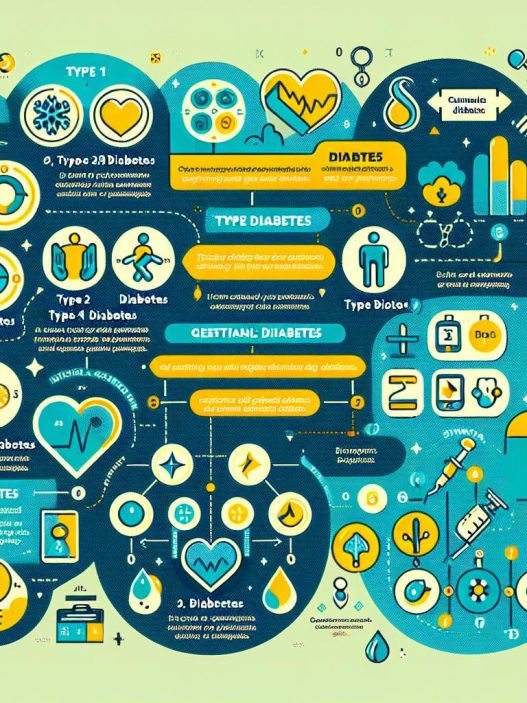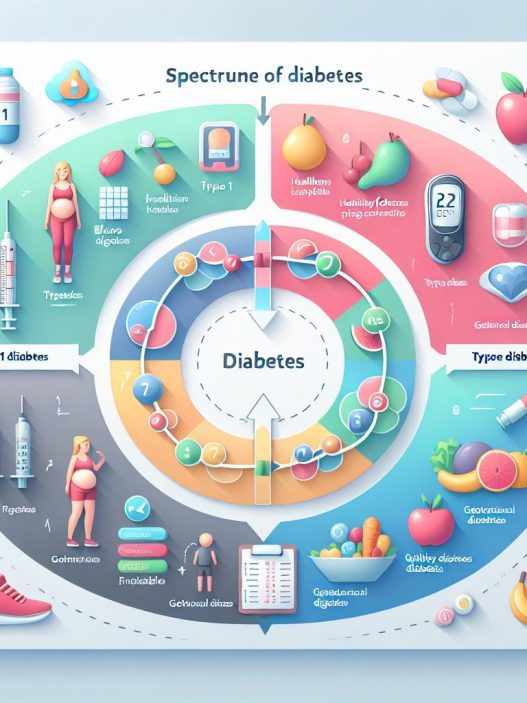# Understanding Diabetes: Exploring the Spectrum from Type 1 to Gestational Diabetes and Beyond
Diabetes is a complex and multifaceted condition that affects millions of people worldwide. Understanding Diabetes: Exploring the Spectrum from Type 1 to Gestational Diabetes and Beyond not only enhances our knowledge but also helps in managing this chronic disease effectively. This comprehensive guide delves into the different types of diabetes, their causes, symptoms, and management strategies, ensuring a holistic view of this metabolic disorder.
What is Diabetes? A Comprehensive Overview
Diabetes is characterized by high blood sugar levels due to insufficient insulin production, insulin resistance, or both. This condition can lead to various complications, including cardiovascular disease, kidney failure, and vision impairment if left untreated. The two most common forms of diabetes are Type 1 and Type 2, but there are also other variations, such as gestational diabetes and MODY diabetes (Maturity Onset Diabetes of the Young). Understanding these different types is crucial for effective prevention and treatment.
Globally, diabetes has reached epidemic proportions, with the International Diabetes Federation estimating that around 537 million adults were living with diabetes as of 2021. This figure is expected to rise, highlighting the urgent need for education and awareness regarding the disease. By understanding the underlying mechanisms, risk factors, and management options, individuals can take actionable steps toward a healthier lifestyle.
Type 1 Diabetes: The Autoimmune Disease
Type 1 diabetes (T1D) is mainly an autoimmune condition where the body’s immune system mistakenly attacks insulin-producing beta cells in the pancreas. People with T1D typically require lifelong insulin therapy, administered through injections or an insulin pump. While the exact cause of this autoimmune response remains unclear, genetic factors and possible viral infections are believed to play a significant role.
Unlike Type 2 diabetes, which often develops in adulthood, Type 1 diabetes can occur at any age, often appearing suddenly in childhood or adolescence. Symptoms may include excessive thirst, frequent urination, extreme hunger, fatigue, and blurred vision. Because T1D can develop quickly, it is crucial for parents and caregivers to recognize these warning signs and seek medical attention promptly.
Management of Type 1 diabetes involves a multi-faceted approach, including continuous blood glucose monitoring, regular insulin administration, and personalized dietary planning. Those with T1D must maintain a delicate balance between carbohydrate intake and insulin dosage to achieve optimal blood sugar levels. A well-structured diabetes care plan can aid individuals in leading healthy and fulfilling lives despite their condition.
Type 2 Diabetes: A Lifestyle-Related Condition
Type 2 diabetes (T2D) is the most common form of diabetes, accounting for approximately 90-95% of all diabetes cases. Unlike Type 1 diabetes, where the body does not produce insulin, Type 2 diabetes is characterized by insulin resistance, where cells in the body do not respond effectively to insulin. This resistance, combined with a relative lack of insulin production, results in elevated blood sugar levels.
Several lifestyle factors contribute to the development of Type 2 diabetes, including obesity, physical inactivity, poor diet, and genetic predisposition. Environmental factors, such as a sedentary lifestyle and access to healthy foods, also play a critical role. Consequently, Type 2 diabetes often develops gradually, and symptoms may remain unnoticed for years, contributing to long-term health complications.
Managing Type 2 diabetes typically begins with lifestyle modifications, such as adopting a well-balanced diet, increasing physical activity, and losing weight. In some cases, medications or insulin therapy may be necessary to regulate blood sugar levels. Regular medical check-ups are essential for monitoring blood sugar levels and preventing complications.
Gestational Diabetes: Diabetes During Pregnancy
Gestational diabetes (GD) occurs during pregnancy and can affect the health of both the mother and the developing fetus. It is marked by high blood sugar levels that typically resolve after childbirth; however, women with gestational diabetes are at a greater risk of developing Type 2 diabetes later in life. Risk factors for GD include obesity, advanced maternal age, and a family history of diabetes.
Symptoms of gestational diabetes can be subtle and may include excessive thirst, frequent urination, fatigue, and blurred vision. It is essential for pregnant women to receive appropriate screening for gestational diabetes, usually conducted between the 24th and 28th weeks of pregnancy. Early diagnosis allows for timely intervention, which can improve health outcomes for both mother and baby.
Management of gestational diabetes largely focuses on monitoring blood sugar levels, following a healthy eating plan, and maintaining regular physical activity. In some cases, insulin therapy may be required to control blood sugar levels. Following childbirth, blood sugar levels typically return to normal, but women are advised to have regular check-ups to monitor their risk for future diabetes.
Understanding Prediabetes: The Warning Sign
Prediabetes is a critical stage where blood sugar levels are higher than normal but not yet high enough to be classified as Type 2 diabetes. This condition signifies an increased risk of developing diabetes, heart disease, and stroke. Approximately 88 million American adults have prediabetes, with many unaware of their condition.
Risk factors for prediabetes largely overlap with those for Type 2 diabetes and include obesity, sedentary lifestyle, family history, and age (45 or older). Many individuals with prediabetes experience no noticeable symptoms; therefore, routine screenings are essential for early detection.
The good news is that lifestyle changes can reverse prediabetes. Engaging in physical activity, losing even a modest amount of weight, and adopting healthier eating habits can effectively lower blood sugar levels and substantially reduce the risk of progressing to Type 2 diabetes. Education and awareness can empower people to make meaningful changes to their health.
Managing Diabetes: Strategies for a Healthier Life
Effective diabetes management involves a holistic approach encompassing medication, lifestyle changes, and regular health monitoring. For those with Type 1 diabetes, an effective diabetes management plan includes routine blood sugar checks, insulin therapy, and carbohydrate counting. In contrast, Type 2 diabetes management may revolve more around lifestyle changes.
Eating a balanced diet rich in whole grains, lean proteins, healthy fats, fruits, and vegetables is vital for effective diabetes management. Foods high in fiber can help stabilize blood sugar levels and promote digestive health. Additionally, staying hydrated and minimizing the intake of processed foods, sugar, and refined carbohydrates plays a crucial role in diabetes care.
Regular physical activity enhances insulin sensitivity and can help regulate blood sugar levels. Simple ways to incorporate exercise into your daily routine include walking, cycling, swimming, or participating in group activities. Furthermore, stress management techniques—such as yoga, meditation, or engaging in hobbies—can also contribute positively to blood sugar control.
The Future of Diabetes Research: Innovations on the Horizon
As our understanding of diabetes deepens, ongoing research continues to explore innovative treatments and technologies aimed at improving the quality of life for individuals living with diabetes. Advances in medical technology, such as continuous glucose monitoring (CGM) and insulin delivery systems, enable individuals to manage their condition more effectively and with greater convenience.
In addition, researchers are investigating the potential of gene therapy, which may one day provide a cure for certain types of diabetes, particularly Type 1, by restoring normal insulin production. Immunotherapy treatments are also being studied to identify and eliminate the immune response that causes the destruction of insulin-producing cells.
Despite the ongoing challenges associated with diabetes, education, awareness, and technological advancements offer hope for better management and prevention. The more we understand these complex conditions, the more empowered individuals can feel in making informed decisions about their health.
In conclusion, understanding the spectrum of diabetes—from Type 1 to gestational diabetes and beyond—equips individuals with the knowledge to navigate this complex disease. With ongoing research and advancements in medical science, the future looks promising as we strive for better management, prevention, and ultimately, a cure for diabetes.

